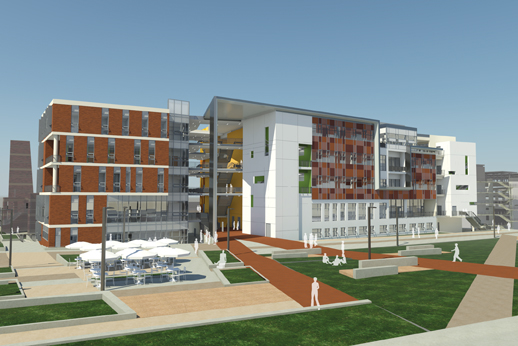California is a breeding ground for building information modeling and integrated project delivery. Major healthcare owners such as Sutter Health and Kaiser Permanente have reaped huge savings from using BIM in the design stage and co-locating their Building Teams early in the process. These efforts pale in comparison to the massive scale of BIM and integrated delivery requirements of the Los Angeles Community College District.
LACCD is currently undergoing a $6 billion construction program on all nine of its campuses throughout Los Angeles County, the most populous county in the U.S. (2010 Census: 9,818,605). To win any of the design-build contracts for new buildings or retrofits, Building Teams must agree to a rigorous BIM program that demands compliance with strict rules on workflow, information sharing, and early design collaboration. The requirements are spelled out in considerable detail. A typical example: “For Spatial Coordination, BIM Facilitator will integrate the design discipline and trade-specific models into a consolidated 3D-model using coordination software.”
Under LACCD’s BIM/IPD procedures, Building Teams must name a lead facilitator to coordinate BIM workflow on behalf of the architect, engineer, or design-build contractor for the entire duration of the project. There are specific requirements for shared data servers and detailed standards for project kickoff orientation meetings. There’s even a stipulation that the designer provide a virtual theater for viewing of 3D models by the entire Building Team.
Design and construction firms that want to work with LACCD must not only agree to the District’s BIM/IPD requirements (http://standards.build-laccd.org/projects/dcs/pub/BIM%20Standards/released/content.html) and modeling standards as a condition of employment, they must also submit to project tracking on LACCD’s BIM project website and agree to turn over their BIM models at the end of construction to LACCD for the owner’s use in managing the facilities.
“We focus on the life cycle of a building,” says Jim Youngblood, the LACCD’s BIM and virtual design and construction manager. “We want anyone working on a project for us to know the importance of the big picture,” Youngblood says that throughout the history of LACCD’s Sustainable Building Program, design and construction consultants have asked him, “Is modeling to this level truly that important and useful to you?” His response: “It is, because we will be using this data for the entire life of these buildings.”
BuildLACCD dates back to 2001, when Los Angeles County voters approved the first of three successive bond measures providing the bulk of the program’s $6 billion in funding. While modernizing the nine colleges was the main priority of the program, LACCD has also used the program to focus on cutting-edge green building techniques, and it has won several awards for its sustainable construction practices. Youngblood says embracing BIM technology is another crucial step toward the LACCD’s sustainability and cost-efficiency goals.
To help design-build teams new to the technology get their footing, BuildLACCD has created its own blog, http://bimlaccd.blogspot.com/, to share success stories, get the word out about BIM workshops run by the LACCD, offer other training opportunities, and share news about of the latest Southern California BIM news.
Youngblood, LACCD BIM manager Michael Cervantes, who oversees the entire LACCD BIM program with assistance from Youngblood, and LACCD BIM designer Giovana Romero are all “active” owners who make a point of attending Building Team meetings for LACCD projects to make sure the BuildLACCD process is being carried out. They recognize, however, that simply requiring BIM and integrated project collaboration is one thing, but following through on such a sophisticated set of requirements is another.
Following are two case studies that give a feel for how BIM is being implemented in LACCD projects.
LOS ANGELES HARBOR COLLEGE—DESIGNING FOR CONSTRUCTABILITY
The Los Angeles office of HGA Architects and Anaheim-based Pinner Construction are the design-build team behind a new 73,767-sf, three-story Science Complex for LA Harbor College. When it’s completed next year, the new complex will consist of two L-shaped, steel-frame structures set perpendicular to each other: a three-story east wing housing laboratories, and a two-story west wing housing lecture halls, classrooms, and offices. The wings are connected via a bridge over a walkway. The L-shaped orientation addresses a primary campus entrance from the parking area, directing pedestrian circulation through the site.
In pursuit of a LEED Platinum rating from the U.S. Green Building Council, HGA and Pinner have developed a strategy that includes self-generation of energy striving to achieve net-zero energy, a 42% energy reduction over California’s Title 24 baseline, 57% water use reduction, and 36% energy self-generation from building-integrated photovoltaic panels. Such a complex building likely would have required BIM and energy modeling in the design stage, even if LACCD didn’t require them.
“It would have been very difficult without Navisworks for clash detection in the first place,” says Matthew Dunbar, HGA’s BIM coordinator on Harbor College. “Pinner Construction’s superintendents went through the Navisworks models with everyone else and flagged areas for constructability and worked with us early in design. That was feedback we wanted and needed.”
Dunbar says the team had frequent meetings via WebEx to go over the shared Navisworks model and got input from subcontractors on how the design model could be used for constructability. He says having a BIM program that forced the entire Building Team to meet and validate their results was helpful in getting the design finalized.
“LACCD was one of the first clients we had that had a standardized process they wanted us to walk through,” he says. “Having done projects before where we had owners who have no idea what we’re doing, or ones who just see dollar signs from BIM, it’s nice to have someone who provides a framework. It was immensely helpful to have this process define what you’re doing.”
James Matson, a principal with HGA’s Los Angeles office, says, “On the design side, the work effort occurs earlier in the process. A well-coordinated team of designers and subcontractors is crucial to making the right design decisions early. This coordinated design effort allows the contractor to begin shop drawings earlier.”
While there was feedback from contractors and subcontractors in the design stage, a new model expressly built for constructability was still needed to go from design to construction.
“We’re adding things that the design side doesn’t think about,” says Roger Charbonneau of AEC Factory, Torrance, Calif., the BIM modeler for Pinner Construction on Harbor College. These neglected components include hangers, bracing, and deck inserts, which AEC Factory added to the construction model and exported out to CAD; from there, the construction team put those components into a Trimble field layout system before construction. “On the design side there are still things that need coordination once the design model is turned over—things like pipe clearances, fireproofing, light-gauge steel,” says Charbonneau. “We’re doing all of that before we get to the field. At the end of the day, the design model and construction model are different.”
Earlier projects at LACCD have even had facilities managers involved. Both mechanical and plumbing subcontractors have done serviceability walks with the facilities system foreman who will ultimately receive the building. This is a system-specific walkthrough, floor by floor, done in Navisworks, Bentley Navigator, or some other BIM navigation program before construction begins.
Theoretically, RFIs and change orders should not occur on LACCD projects, since all Building Team members are coordinating early in the design process. Nonetheless, says Charbonneau, there is still a certain degree of apprehension among Building Team members with making so many crucial decisions so early in the process.
“In design-build we’re on the same side, but that’s not the case in all projects,” Charbonneau says. “Anything we can automate or prefabricate on the construction side is saved money.” The same is not necessarily true on the design side, he says. “In design, those savings aren’t really quantifiable yet. What is saved design time worth?” he asks.
EAST LOS ANGELES COLLEGE—ENCOURAGING STUDENT-FACULTY COLLABORATION
HGA and Pinner’s latest project for the LACCD is the Student Success and Retention Center, a 130,000-sf, $55 million, five-story classroom, office, and language lab building for East Los Angeles College. It consolidates nine departments into a flexible learning environment that encourages collaborative student-faculty interaction while incorporating sustainable strategies to achieve LEED Gold and net-zero energy consumption. Design was recently completed; the scheduled opening is early 2014.
A key to winning this project was keeping the entire HGA/Pinner design-build team together, including subcontractors. The collaboration and early modeling efforts that were pioneered on Harbor College paid off on this project. “Everyone comes back into place and is more efficient,” says HGA’s Dunbar. “We knew the LACCD process better on this one, and that’s really a roadmap for all these projects.” The HGA/Pinner team is competing for a third LACCD project.
“An owner is forcing its teams to work in BIM the way they want them to, and they have $6 billion dollars in new work,” says the AEC Factory’s Charbonneau. “Every player in the team has to be involved. You have a lot of old dogs who don’t want to change, but if they’re on one of these projects they have to. The high-performance team is really hitting its stride on East LA College.” BD+C
BD+C Contributing Editor Jeff “BIMBoy” Yoders blogs on BIM and related design/construction IT topics at www.BDCnetwork.com
Related Stories
Building Team | Apr 20, 2022
White House works with state, local governments to bolster building performance standards
The former head of the U.S. Green Building Council says the Biden Administration’s formation of the National Building Performance Standards Coalition is a “tremendous” step in the right direction to raise building performance standards in the U.S.
Market Data | Apr 20, 2022
Pace of demand for design services rapidly accelerates
Demand for design services in March expanded sharply from February according to a new report today from The American Institute of Architects (AIA).
Multifamily Housing | Apr 20, 2022
A Frankfurt tower gives residents greenery-framed views
In Frankfurt, Germany, the 27-floor EDEN tower boasts an exterior “living wall system”: 186,000 plants that cover about 20 percent of the building’s facade.
AEC Tech | Apr 19, 2022
VDC maturity and the key to driving better, more predictable outcomes
While more stakeholders across the AEC value chain embrace the concept of virtual design and construction, what is driving the vastly different results that organizations achieve? The answer lies within an assessment of VDC maturity.
Healthcare Facilities | Apr 19, 2022
6 trends to watch in healthcare design
As the healthcare landscape continues to evolve, IMEG’s healthcare leaders from across the country are seeing several emerging trends that are poised to have wide-ranging impacts on facility design and construction. Following are six of the trends and strategies they expect to become more commonplace in 2022 and the years to come.
Concrete Technology | Apr 19, 2022
SGH’s Applied Science & Research Center achieves ISO 17025 accreditation for concrete testing procedures
Simpson Gumpertz & Heger’s (SGH) Applied Science & Research Center recently received ISO/IEC17025 accreditation from the American Association for Laboratory Accreditation (A2LA) for several concrete testing methods.
Sponsored | BD+C University Course | Apr 19, 2022
Multi-story building systems and selection criteria
This course outlines the attributes, functions, benefits, limits, and acoustic qualities of composite deck slabs. It reviews the three primary types of composite systems that represent the full range of long-span composite floor systems and examines the criteria for their selection, design, and engineering.
Building Team | Apr 18, 2022
Shive-Hattery Acquires WSM Architects
Shive-Hattery announces that it has acquired WSM Architects, Inc., a 13-person architecture firm in Tucson, Arizona.
Building Team | Apr 15, 2022
Frank Gehry to design his largest building yet for his hometown of Toronto
Famed architect Frank Gehry will design his largest building to date for his hometown of Toronto, Canada.
Healthcare Facilities | Apr 14, 2022
Healthcare construction veteran creates next-level IPD process for hospital projects
Can integrated project delivery work without incentives for building team members? Denton Wilson thinks so.
















